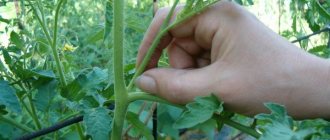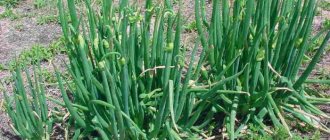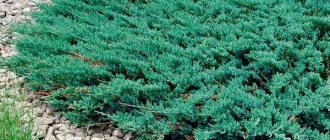Specifics of growing parsley in a greenhouse
Greenhouse cultivation of parsley has its advantages and disadvantages associated with both the cultivation and the further use of cut greens.
Advantages
The main advantage of growing greens in a greenhouse is the possibility of year-round harvesting, not only for personal use, but also for sale. Additionally, the average greenhouse area is much larger than the window sill space, so for those who regularly use it for this purpose, a greenhouse structure is an ideal solution to limited space.
- Other advantages of greenhouse cultivation of root crops include:
- improved protection of plants from diseases and pests (though only if legumes, cabbage, onions, tomatoes or other undesirable precursors were not grown in the same greenhouse before sowing carrots);
- ease of care (growing greens in a greenhouse is much easier than vegetables or fruits);
- constant replenishment of vitamin reserves during the cold season;
- obtaining economic benefits, since the cost of selling finished greens is much higher than the funds spent on purchasing planting material (greens are always in demand during the cold season);
- the possibility of growing plants even in an unheated greenhouse (though mostly in the southern regions and most of the central territories of the Russian Federation).
Flaws
- With all its undeniable advantages, cultivating parsley in a greenhouse can also have some negative aspects:
- cut greens are not suitable for long-term storage, so you will have to find places of sale in advance or prepare appropriate storage for storing frozen or dried greens;
- for year-round cultivation in regions with a harsh climate, you will have to take care of a heating system, the cost of which can be quite significant;
- The variety of parsley must be selected taking into account its frost resistance, especially for those cases when we are talking about unheated structures.
With well-organized care, these shortcomings will be practically unnoticeable, therefore, by putting maximum effort into greenhouse cultivation of greenery, you will receive more benefits than by cultivating it in open soil.
Parsley requirements for soil, lighting and other conditions
Growing greens in a greenhouse is convenient because even in winter you can get a lot of fresh parsley. There is more space in a greenhouse than in containers on the windowsill, which means there will be more harvest. The greens are very frost-resistant and thrive in the winter. But it is still not recommended to plant greens in a greenhouse that is heated before the beginning of February.
Note!
If there is no heating system in the greenhouse, you should not plant greens in winter.
The temperature in the greenhouse should be +12 degrees. If you overheat the air in a greenhouse to 20 degrees, it will not benefit the vegetation. If the temperature is higher, the greens may dry out completely. To avoid this, the plant must be protected from the sun's rays. To harvest a quality harvest in winter, you need to follow these tips:
- Unnatural lighting has a beneficial effect on the formation of greenery.
- The plant does not tolerate direct sunlight. It needs daylight.
- To prevent the soil from becoming dry, after harvesting, the vegetation is irrigated.
- If the humidity in the greenhouse is above 75 percent, the greens will grow steadily.
- Frequent changes in the degree of heat negatively affect parsley.
- To maintain the recommended conditions, the greenhouse must be ventilated.
You can start planting greenery in greenhouse soil at the end of February. Parsley can withstand temperatures down to -9 degrees, and seed germination occurs at temperatures from 0 to +5 degrees. Due to portability, green seeds can be sown in early November during winter, which will make it possible to harvest early.
It is recommended to sow the leaf variety every 2 weeks to ensure constant harvesting of a new crop.
Choosing a variety for growing in a greenhouse
Not all varieties of parsley are equally well suited for planting in a greenhouse, so in order to get the maximum yield of greenery, more attention should be paid to the issue of choosing a specific variety.
Learn how to grow parsley on a windowsill from seeds.
The list of main selection criteria in this case includes the following characteristics:
- the relevance of cultivation in a specific climatic region;
- possibility of cultivation in closed soil;
- high resistance to diseases and insect pests characteristic of greenhouse conditions;
- maximum yield per unit area;
- Variety of parsley: leaf or root.
Each of the groups (leaf or root) has its own examples of the most suitable varietal varieties for greenhouse cultivation. In the first case, these are: Breeze, Moskrauch, Bravo, Esmeralda (average plant height is 60 cm with a leaf rosette diameter of 30 cm), and in the second (root greens) - Harvest, Root Berlin, Leaf, Bordovik (despite late ripening, different high shelf life, for which it is valued by gardeners).
Varieties for growing parsley in a greenhouse. Both versions of parsley include varieties of medium and late ripening, but when cultivating in a greenhouse this is not so important - however, only when you grow the plant for yourself and not for sale. In the latter case, it is important to sow and cut green leaves more often.
Which type and variety to choose
Parsley comes in the following types:
- Root parsley. Its features are thick and dense roots. Used for making sauces and pickling. The greens of this plant are eaten, but only after the root has matured.
- Leaf parsley. Only greens are considered suitable for consumption, since they have a much more delicate taste. Plants grow up to half a meter in height and 30 centimeters in diameter.
When choosing a variety, you should decide on the desired product: root or greens.
Preparing soil and seed
Parsley does not have any special requirements for the composition of the soil, but moderately fertilized soils, light loamy or soddy-podzolic type, are considered a more preferable option. On heavy and clogged substrates, root crops grow poorly, and even if they reach the sizes declared by the manufacturer, they almost always have clumsy and ugly shapes.
Did you know? You can make an excellent anti-hangover cocktail from parsley by mixing it with cilantro, mineral water and kefir in a ratio of 1x1x1x1, and then making a smoothie using a blender.
Before planting in a greenhouse, the soil must be properly prepared by mixing garden soil with peat and spilling it all with a solution of copper sulfate. This substance will help destroy all pest larvae and pathogens living inside, after which it will be possible to add a small amount of complex mineral compounds and wood ash to the soil.
The higher the copper content in the solution, the more effective its effect! After mixing the nutritional components, the substrate must be loosened well and furrows must be arranged at a distance of 15–20 cm from each other, adhering to the recommended depth of 10–15 cm for planting parsley rhizomes and 2–3 cm for sowing seeds. Of course, how exactly to sow the root crop is up to you, but it is still necessary to adhere to the general placement scheme on the site.
Preparation of the seeds themselves consists of the following sequential steps:
- Sorting (seed material is soaked in water for 3 hours, and then all floating empty specimens are rejected).
- Germination . To perform this procedure, the seeds are placed in a wet cloth folded in several layers and left at room temperature for 4-5 days, constantly maintaining the moisture of the material until the sprouts appear.
- Hardening . Seeds that have already sprouted are sent to the refrigerator for 10 days, maintaining the temperature inside within +1...+2°C.
Sprouting seeds is a must for preparing parsley seeds!
Useful tips
We sow dill
- In cool spring, it is recommended to wrap the sowing site with film. This is done so that the seedlings do not die at night during frost.
- Before cutting off the green mass the day before, the plants need to be well watered so that the greens are juicy. You can keep plants for a longer time if you remove them with their roots and put them in a plastic bag.
- there is a specialist in growing vegetables.
- requires constant loosening of the soil;
- In late autumn, make sure that a crust does not form on the ground.
- Annual plant. Early ripening species. Before planting, soak the seeds for 2 days in warm water. This way they will ripen faster. Be sure to change the water 3 times a day. Growing features:
- The plant is growing well. Indentation – no less than 15cm;
Planting and growing from seeds
Seed planting of greens is the simplest and most common option for cultivating them. All that is required of the gardener is to properly prepare the seed and beds, and then place the seeds in the furrows, keeping about 3-5 cm of free space between them. At the end of planting, the placed seeds are sprinkled with soil, compacted and watered abundantly with settled water.
Important! For good growth and development of greenery, it requires a sufficient influx of sunlight, so if there is not enough lighting in the cold season, it is worth organizing artificial lighting in the greenhouse by installing fluorescent lamps around the perimeter.
If there are a large number of seeds, you can sow them a little thicker, and after germination, leave only the strongest of them. In the future, all that is required from the gardener is to monitor the optimal temperature in the room (not lower than +10°C) and periodically moisten the soil, while simultaneously removing weeds. The optimal humidity level for growing parsley is 70–80%.
Planting greenery in closed ground can be done not only by seed, but also by planting rhizomes, which are first kept in sand for 24 hours at a temperature of +2°C. While the rhizome is “infused” in the sand, furrows need to be arranged in the prepared bed, at a distance of 10 cm from each other.
Also read about how to sow parsley correctly so that it sprouts quickly.
They are generously moistened with water, after which root crops are placed there at intervals of 10 cm, deepening them into the ground at an angle of 45°. Planted specimens need to be sprinkled with soil, but only so that the root collar remains above the soil surface, compacted a little and watered generously. In about a month, the height of the leaves will reach 25 cm and they can be cut for greens.
Harvesting
If you properly care for the crop, then parsley has a yield per 1 square meter. m will be 1.5-2 kg per sowing. How long can greenery grow? Planting treated seeds will shorten the ripening period to 3 weeks. Planting dry seeds will extend it to 1.5 months.
Root varieties are dug up before the first frost. The leaves are cut off and the roots are stored in the cellar, sprinkled with coarse river sand.
The greens, which are grown in heated greenhouses and greenhouses, are cut year-round. The harvest can be dried or frozen in freezers.
Parsley is completely unpretentious and does not require much labor to take care of itself. It is beneficial to grow it all year round in greenhouses, thanks to which healthy and nutritious greens will be constantly available. It is important to observe the temperature regime, apply fertilizing and remove weeds.
How long does parsley grow in a greenhouse?
The germination time of parsley largely depends on the method of preparing the seed material: if the seeds are planted dry, then the shoots will appear no earlier than in a month. If the seeds were pre-soaked in water for several days and they managed to sprout, their germination rate in the greenhouse will be doubled. A few weeks after the appearance of green sprouts, it will be possible to cut the first harvest.
Soil preparation
To plant greenery in a greenhouse, you should prepare an insulated, illuminated area on loose, fertile soils.
Attention!
Of the greenhouse plants, the best predecessors for parsley are cucumbers and tomatoes, while all umbelliferous plants are poor.
The quality of the harvest depends on certain conditions. The main factor for growing parsley is high-quality soil. It is necessary to organize preparation of the site. To do this, saturate the soil with fertilizer. The best period for care is the autumn season. Soil amendments can also replace rotted leaves, manure or compost. With fertilizers, plant species with leaves are well formed.
To plant parsley in the fall before winter, the place for planting the seeds must be prepared no later than 14 days before starting work. After fertilizing the soil, generously irrigate the area with water and cover with cellophane film. Earthworms provide humus to the soil. They will help resolve this issue in a couple of weeks. This method eliminates the need to use suspicious fertilizers.
Caring for greenhouse parsley
Caring for parsley in greenhouse conditions is based on the same actions as when growing the crop in open soil.
In any case, the main activities will be:
- timely watering of crops;
- loosening row spacing;
- plant fertilizer.
The need for additional moisture of the substrate can be determined based on the condition of the upper soil layer: if the soil clenched in a fist crumbles or becomes dusty, it’s time to water the parsley using the sprinkling method. When using jet watering, you can wash the seeds out of the soil, so you should not use this method.
If organic fertilizers were used when preparing the bed for planting parsley, then during further cultivation it is worth using only complex mineral fertilizers (including phosphorus-potassium fertilizers), applied according to the manufacturer’s recommendations. When choosing the type of suitable fertilizer, you should also focus on the variety of planted parsley.
Important! Fresh, unrotted manure is not the best solution for fertilizing parsley plantings. Such a composition may well burn tender sprouts, thereby depriving the gardener of the harvest.
For example, leaf-type varieties are fed with saltpeter twice a season, at the rate of 50–60 g of the substance per 1 m², while it is more appropriate to apply phosphorus-potassium fertilizers under root parsley. Complex mineral compositions in the spring will be relevant for any type of greenery, and during the period of root crop formation, parsley is well fed with potassium salt, at the rate of 50 g per 1 m² of plantings, and superphosphate - 70 g per 1 m².
Features of business on greenery
The characteristics of the region should be taken into account for the successful construction of a greenhouse economy. Ideally, it begins in the south of the country, where there is a warm and mild climate. In a cold region, there is always a risk of crop loss from frost and increased production costs, when heating and electricity costs compensate for all income from the sale of the crop. Sometimes it may even be more economically profitable to spend money on delivery from another, climatically favorable area. Before starting a business, you should once again weigh the pros and cons.
❗ Greenhouse size 18 sq. meters will incur heating costs in the cold season in the region of 80 thousand rubles. And already in the middle zone, costs will increase to 250,000 rubles.
Greenhouse soil consists of various types of peat, standard garden soil, various types of compost, wood waste, sawdust, litter, straw, river sand and manure. It is recommended to make the minimum layer for the soil layer 25-30 centimeters. To produce plants, you can use typical disinfected garden soil mixed with fertilizers and peat. Microgreens do not require fertilizers at all, just enough soil and peat.











